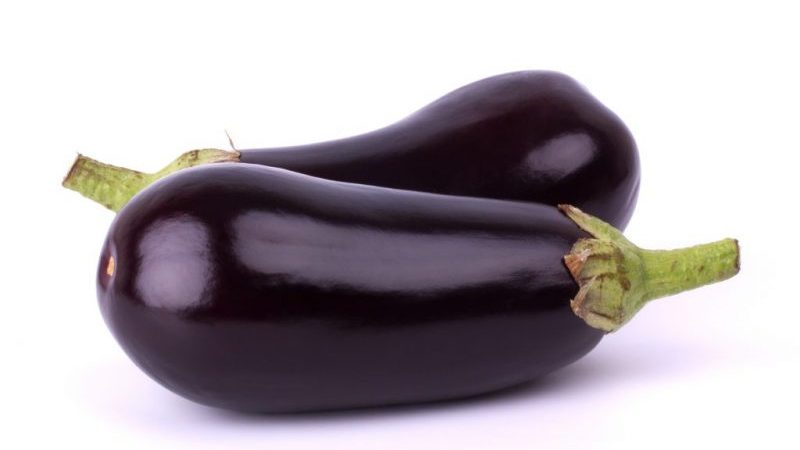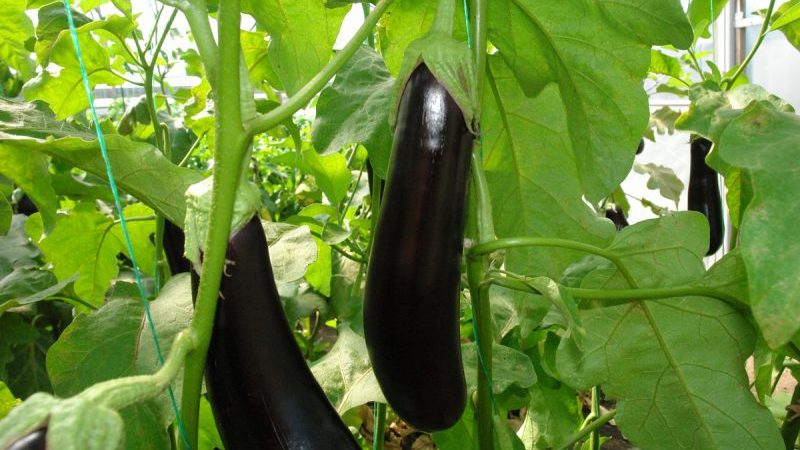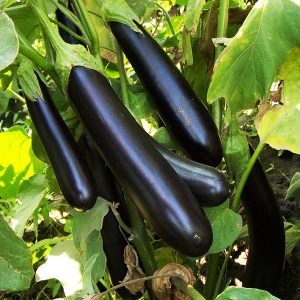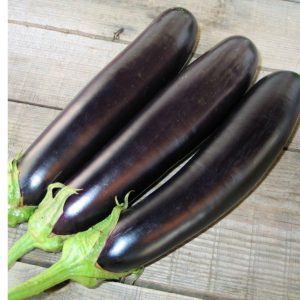Heat-loving hybrid of eggplant "Valentina f1" from Dutch breeders
Eggplant Valentina F1 of Dutch selection is one of the best hybrids grown in central Russia. Unpretentiousness, early ripeness and productivity make it possible to recommend it to both beginners and experienced gardeners. This is one of the earliest eggplants that bears fruit as early as mid-July. It is famous for its delicate, mild taste.
Consider the detailed characteristics and agricultural techniques.
The content of the article
Description of culture
The Valentine F1 eggplant hybrid was developed in the 90s of the last century by the Dutch company MONSANTO HOLLAND B.V. It was entered into the State Register in 2007. Eggplant is zoned for cultivation in all regions of the country and is suitable for greenhouses, open ground and temporary film shelters.
Distinctive features
The hybrid is tall, has thin and long fruits 20–27 cm long and 5 cm in diameter. Early maturity and yield are considered valuable characteristics. The hybrid is resistant to adverse climatic conditions, does not shed buds and flowers. Fruit development continues even in cold weather. Fruits are uniform in size, tolerate transportation well. The hybrid is resistant to tobacco mosaic.

Specifications
Valentine F1 grows in a tall, spreading bush. In greenhouse conditions it reaches 1 m, in open ground - 70–80 cm. Large leaves are painted in intense green. The flowers are pale purple in color.
Fruits are oblong, pear-shaped, black and purple in color. Ripening begins 2–2.5 months after planting, the first eggplants are removed in July. The mass of one fruit reaches 300 g. The pulp is white, with a yellow tint, without bitterness. The vegetable contains few seeds.
The yield in the open field is 2.8–3 kg, and in greenhouse conditions it reaches 5 kg per square meter. m.
How to grow yourself
Eggplant has a long growing season, which is why it is grown through seedlings. Sowing time when planting in a greenhouse is the second or third decade of February, in open ground - early March.
Growing seedlings
The largest ones are selected from the seeds. The planting material is disinfected in a solution of potassium permanganate or "Fitosporin". The seeds of Dutch hybrids are sold already processed, but some gardeners soak them in a biostimulator, for example, "Heteroauxin", to improve germination.
The seed germination method is often used. To do this, they are kept moist at a temperature of + 25 ... + 27 ° C until sprouts appear.
You can prepare the soil for sowing yourself or buy it ready-made in the store. Soil composition:
- sod land - 10%;
- humus - 20%;
- peat - 60%;
- sand or sawdust - 10%.
Attention! Any soil should be disinfected before use.
Eggplants do not tolerate picking well, so it is recommended to sow sprouted seeds in small pots, and then, as they grow, transfer them with a lump of earth into a container of larger diameter.
Seeds are sown to a depth of 1 cm, covered with glass or foil on top and placed in a warm place with a temperature of about +25 ° C.
After the emergence of seedlings, the film is removed, and the pots with seedlings are placed in a bright place. Since the crop is sown in winter, additional lighting has a beneficial effect on the development of seedlings.
Top dressing of eggplant seedlings is required only if humus was not used during planting. If the soil is fertile enough, the seedlings may not be fed before planting in the ground.
Transfer
Two weeks before transplanting, young plants must be hardened, starting at several hours and gradually leaving in the fresh air for a longer time. Hardening helps plants adapt to sunlight and daily temperature changes.
Seedlings ready for planting have a thick stem and at least five true leaves. The seedlings should be more than two but less than three months old. A sign of the seedlings' readiness for transplanting is the appearance of the first buds.
Growing eggplants in the open field is only possible for experienced gardeners. Usually this crop is planted in greenhouses or hotbeds.
The required soil temperature for planting this heat-loving plant is considered to be + 19 ... + 20 ° C, which is problematic for open ground.
In the greenhouse, holes are prepared for planting eggplants at a distance of 50 cm, a handful of wood ash is placed in each hole. Before planting, the hole is spilled with water, the seedling is deepened to the cotyledon and the earth around is lightly tamped.
Reference. Bell peppers, green crops and legumes will become good neighbors for the vegetable.
Further care

The temperature is considered favorable for the growth and fruit setting of +25 .. + 28 ° С... At below +15 ° C, the plant stops growing, and when overheated above +35 ° C, the pollen becomes sterile and the fruits are not set. Correct the temperature by airing, making sure that there are no drafts that the eggplant cannot tolerate.
When watering, the soil is moistened to a depth of at least 20 cm. During the growing season, water is watered once a week, and during the pouring of fruits - twice a week. It should be watered with warm, settled water.
The aisles are loosened no deeper than 3-5 cm so as not to damage the delicate roots of the plant.
During the season, the culture should be fed 3-4 times. During growth, they are fed with complex fertilizers. During the period of formation and growth of fruits, eggplant requires a lot of potassium. Phosphate-potassium fertilizers are suitable.
Features of cultivation and possible difficulties
The peculiarity of growing eggplants is an indispensable condition for early sowing for seedlings.
Features of watering: eggplants are moisture-loving plants, but they cannot stand stagnant water.
When planting in a greenhouse, it is undesirable to plant eggplants together with tomatoes, since nightshade diseases easily pass on to these delicate plants.
Important! Lack of top dressing negatively affects the development of the bush and fruiting.
Experts recommend forming a bush: to deal with excess foliage, to remove unnecessary stepsons, especially from the lower part of the plants.
Diseases and pests
Eggplants are susceptible to many viral and bacterial diseases; their delicate foliage suffers from pests.
Diseases of eggplant:
- Black bacterial spot. Black spots with a yellow border appear on the leaves, and lesions with ulcers appear on the fruits. For treatment use "Fitoflavin-300".
- Late blight. Brown spots first appear on the leaves, then move to the stems and fruits, and the plant dies. A measure of control is spraying plants with copper-containing fungicides.
- Gray rot (Alternaria). With increased humidity in the greenhouse, gray damp spots appear on the leaves. They fight against them with contact action fungicides, carefully spraying the lower leaves.
Eggplant pests:
- Whitefly... A 5mm white butterfly can cause damage when grown in a greenhouse. Plants are sprayed with Aktara and watered at the root. Other drugs containing avermectins are also used.
- Spider mite. If the pest is small, it is enough to break off the cobweb and remove the damaged parts. Spraying with ammonia solution also helps.
- Colorado beetle. Use preparations "Corado" 1 ml per 5 liters of water, "Aktara" 2 g per 10 liters of water, beetles are collected by hand.
- Aphid. To combat, solutions of laundry soap and ash are used, spraying the plants several times. In case of massive lesions, drugs "Strela", Iskra "and others are used.
Harvesting and application of the crop
Eggplants are harvested as needed from the end of July. Mass harvest is carried out with the onset of cold weather or with the appearance of diseases.
Vegetables are used both fresh and for hot dishes. There are many vegetable and meat dishes with eggplant. They make caviar, various salads, pickle and salt.
Hybrid Valentine F1 tolerates transportation, in cool conditions it is keeping quality - more than 1 month without loss of taste.
Advantages and disadvantages
Advantages of eggplant Valentine F1:
- early maturity - harvesting begins at the end of July;
- high yield and ripening of fruits;
- excellent taste and a small amount of seeds;
- unpretentiousness, the ability to grow and bear fruit under adverse weather conditions;
- the hybrid is practically not affected by the tobacco mosaic virus.
The disadvantages include the small thickness of the fruit and the dense foliage of the bush, because of which you have to cut off excess leaves.
Reviews
The gardeners growing Valentine f1 eggplant unanimously note its resistance to weather conditions and high yield.
Valentina, Yaroslavl region: “We plant these eggplants every year. Due to early maturity, always with the harvest, even in cold summer conditions. I can recommend this hybrid to everyone. "
Natalia, Moscow region, Ozyory: “I like the Valentine F1 hybrid, we plant it all the time. The fruits are large, tasty, not bitter. It can lie for a long time and not deteriorate, it is good at workpieces. "
Andrey, Kirov: “We live in a region with risky farming conditions, we have frosts even in June. We plant the hybrid later than indicated in the instructions, but it has time to ripen. Other varieties had to be removed immature. I think the Valentine hybrid is one of the best for growing in the northern regions. "
Read also:
Unpretentious Robin Hood eggplant variety.
Why summer residents like the "Black Beauty" eggplant variety.
Conclusion
Valentina F1 is an excellent hybrid for growing on a subsidiary farm. It is unpretentious, resistant to diseases, and tolerates any unfavorable weather during the growing season. In addition, it is famous for its high yield and excellent taste. The only drawback is the need to buy seeds every year.